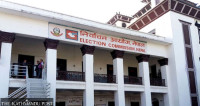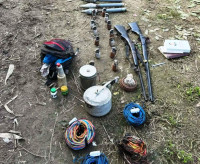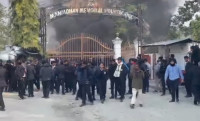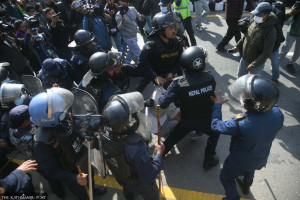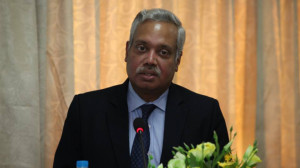National
USAID closure harms pro-democracy development efforts in Nepal
The aid agency supported Nepal’s civil society and local governance. Now NGO sector leaders are scrambling for an alternative funding, with eyes on China and India.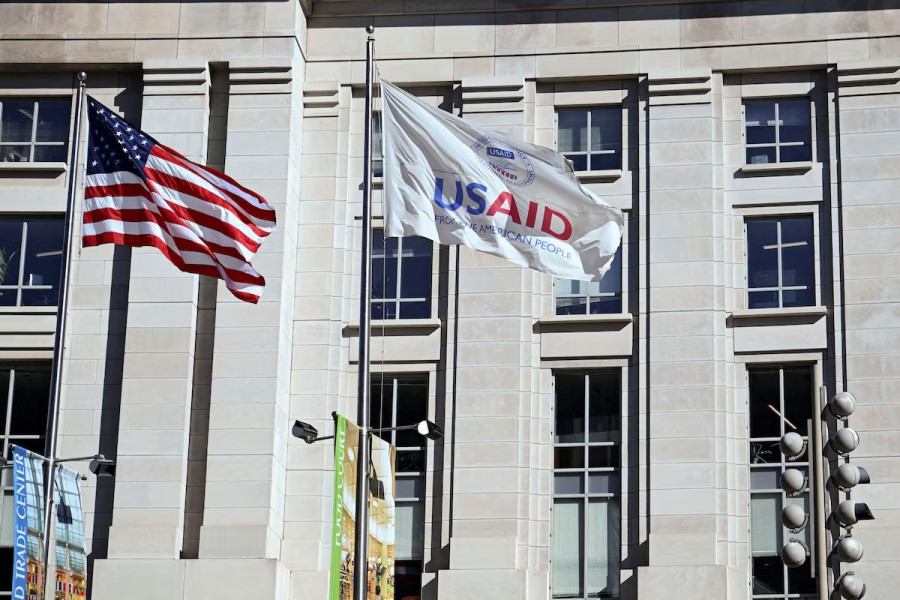
Ellie Davis
Ajay Das served as programme director for the Asia Foundation’s Civil Society and Media programme for two and a half years. The project was funded by the USAID, but in January, Das’ team got word that the Trump administration had canceled their five-year budget worth $18.5 million—and their project would have to stop.
“The objective [of the programme] was to protect independent civil society and independent media,” Das said. “These are fundamental democratic principles.”
He said that the project had to cancel its plans just as its work was starting to make an impact.
Before the USAID closure, the US had committed $695 million in development funding to Nepal over five years, one-third of total funding in the development sector in Nepal, according to NGO Federation Nepal President Arjun Bhattarai. Much of this funding focused on health improvement, but it also contributed to projects aimed at strengthening civil society and local government systems.
With the loss of funding, leaders of the development sector worry that civil society and democracy will suffer, and that new funding from countries like China and India will not prioritise these efforts.
“Our democracy is very new and takes time to strengthen,” Bhattarai said. “So we have to protect this democratic system … This is the big role of civil society. For that, we need the money, and we need resources for the government.”
NGOs have faced scrutiny from Nepal’s government, which has attempted to limit NGO’s permanent employment of foreigners and more closely regulate their economic activity. Bhattarai, however, maintains that the NGO sector has had a positive impact on the country.
“In Nepal, NGOs have been vital partners in building democracy, protecting human rights, and reaching the most marginalised communities with essential services,” he said. “Civil society contributes not just money, but human resources, social capital, and innovation—factors that directly contribute to the national well-being.”
The Civil Society and Media programme from the Asia Foundation focused on providing funding to organisations that supported young journalists, provided media literacy training, and strengthened the role of young civic leaders. The group had offices in Janakpur and Butwal and was working with 56 local partner organisations. The offices have now closed.
Thirty people, including Das, who were a part of the project at the Asia Foundation, and more than 100 people working at the Asia Foundation’s partner organisations, lost their jobs, contributing to the roughly 30,000 total jobs lost that Bhattarai estimates resulted from the USAID funding cuts.
Though former USAID workers have lost their employment, Das emphasised that the most consequential suffering from the loss of USAID has been felt by the people who were benefiting from the Civil Society and Media programme. When the project was canceled, emerging journalists in the Madhesh province were in the middle of a fellowship on in-depth reporting, and children who had dropped out of school were receiving extra classes after school to get extra learning help. Both programmes stopped immediately after the funding freeze.
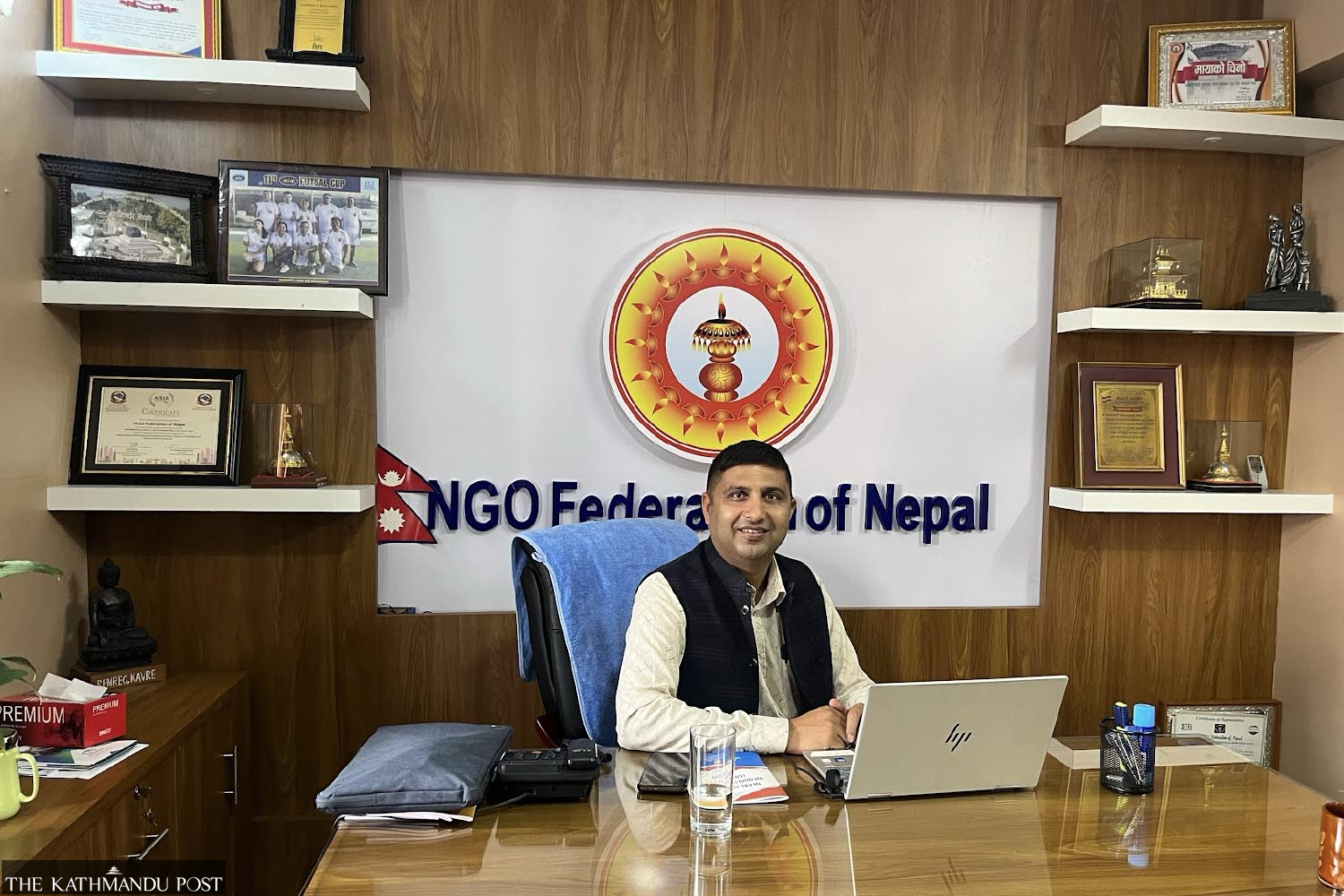
“[The project stopping] has a chain effect, it’s about the people who were being served by the money,” Das said.
In addition to emboldening civil society, other former USAID projects focused on improving local governments’ provision of services.
Plan International Nepal was two years into a $20 million USAID-funded project focused on improving equity and inclusion in education when the funding freeze hit. As a part of this project, the NGO was working to improve local government administration, for example, by ensuring local school management committees were functioning effectively.
According to Plan International’s Country Director Ram Kishan, USAID-funded work supporting local governments was particularly important because Nepal’s federal system of government is still young.
“The constitution of Nepal has a strong foundation, but the federal system is still new,” he said. “Projects from USAID were supposed to work with local governments—that level of support is gone.”
Mercy Corps Nepal, as a part of its humanitarian relief and development work, also focuses on local government capacity building. Its recent projects have helped local governments with tasks such as budgeting, drafting policy, and forming disaster risk reduction plans, while also focusing on strengthening young community members’ engagement with local government.
“We empower youth so that they become constructive partners of the local government and take part in the development processes,” Mercy Corps Country Director Suraj Sigdel said.
Part of Mercy Corps’ aim is helping Nepal fulfill its constitutional promises, Sigdel said. “Nepal’s constitution is very strong, and it has given very specific, strong rights to the marginalised groups—but it's not being implemented,” Sigdel said. “We help the government to realise its constitutional rights.”
Mercy Corps previously received 60 percent of its funding from USAID, and since the funding cuts, the group has had to significantly scale back its work.
After the closure of USAID, other Western countries, particularly European Union members, have followed suit in cutting funding for development projects, according to NGO leaders.
“There is a ripple impact of USAID loss,” Kishan said. “When USAID was there, other donors were also pitching in, because a large part was taken care of. There is no funding from the US government, so other funders are not helping either.”
With less money from the US and the EU, NGO leaders are seeking alternative funding sources. Bhattarai has met with potential NGO investors from China, but this funding is unlikely to prioritise civil society projects.
“They are potential investors, but there is a big problem because their idea of civil society is different,” he said. “China doesn’t want to put money into what the US was doing before.”
Bhattarai added, “Money comes from an ideology. USAID is more a promoter of legalism, democracy and human rights. China brings investment in a different way—not for advocacy, capacity building, mobilisation, and humanitarianism, but more for economic investment.”
In his efforts to identify new funding sources for Plan International from countries including India, China, and South Korea, Kishan has also found that funding civil society projects is less of a priority compared to economic development and trade.
“Trade was always secondary when it came to US donors, but it is primary for new age donors because they start looking at what they can get from investment—civil society doesn’t fit into those priorities.”
Although funding from potential new donors does not prioritise civil society projects, NGOs in Nepal need to explore any potential funding opportunity available, according to Bhattarai.
“In any underdeveloped country like Nepal we have to look at whether [the funding] is a good choice,” he said.
Kishan is hopeful that in the future, the US will reinvest in pro-civil society projects. “I don’t believe that America will never come back and start giving,” he said.
In the meantime, without USAID money supporting local government structures in Nepal, Sigdel thinks they can still work to improve the quality of governance, but that progress will take more time.
“Government development mechanisms are cumbersome and have a lot of restrictions,” he said. “It takes a long time for government capacity building, whereas our USAID mechanism is quite quick.”
Though the future of USAID funding is uncertain, NGO leaders plan to continue their work utilising the foreign support they have already received.
“Many Nepali NGOs today have grown into strong, independent actors precisely because of the support, mentoring, and resources they received through international partnerships,” Kishan said. “Nepal’s civil society has benefited immensely from external collaboration not as a substitute for local initiative, but as an enabler.”




 14.12°C Kathmandu
14.12°C Kathmandu
